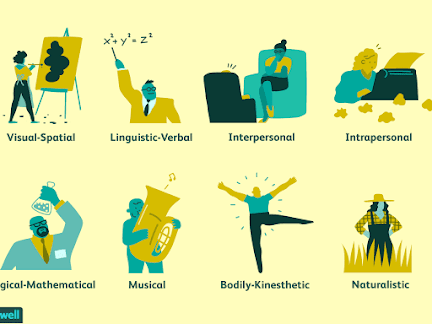Multiple Intelligences - Gardner's Theory
People who are strong in visual-spatial intelligence are good at visualizing things. These individuals are often good with directions as well as maps, charts, videos, and pictures. Career chances: architect, designer, artist etc.
People who are strong in linguistic-verbal intelligence are able to use words well, both when writing and speaking. These individuals are typically very good at writing stories, memorizing information, and reading. Career choices: journalist, lawyer, teacher, writer etc.
Logical-Mathematical Intelligence
People who are strong in logical-mathematical intelligence are good at reasoning, recognizing patterns, and logically analyzing problems. These individuals tend to think conceptually about numbers, relationships, and patterns. Career chances: mathematician, engineer, computer programmer, accountant etc.
Bodily-Kinesthetic Intelligence
Those who have high bodily-kinesthetic intelligence are said to be good at body movement, performing actions, and physical control. People who are strong in this area tend to have excellent hand-eye coordination and dexterity. Career choices: dancer, builder, actor, sportsperson etc.
Musical Intelligence
People who have strong musical intelligence are good at thinking in patterns, rhythms, and sounds. They have a strong appreciation for music and are often good at musical composition and performance. Career choices: musician, composer, singer, conductor etc.
Interpersonal Intelligence
Those who have strong interpersonal intelligence are good at understanding and interacting with other people. These individuals are skilled at assessing the emotions, motivations, desires, and intentions of those around them. Career choices: psychologist, counselor, salesperson, politician.
Intrapersonal Intelligence
Individuals who are strong in intrapersonal intelligence are good at being aware of their own emotional states, feelings, and motivations. They tend to enjoy self-reflection and analysis, including daydreaming, exploring relationships with others, and assessing their personal strengths. Career choices: philosopher, theorist, writer etc.
Naturalistic Intelligence
Naturalistic is the most recent addition to Gardner’s theory and has been met with more resistance than his original seven intelligences. According to Gardner, individuals who are high in this type of intelligence are more in tune with nature and are often interested in nurturing, exploring the environment, and learning about other species. These individuals are said to be highly aware of even subtle changes to their environments. Career choices: biologist, gardener, farmer, conservationist etc.




Hey Abjela, I really liked you post especially the part where it is claimed that it is extremely important not to classify and fixate on these types of intelligences and generalize every behavior and learning style on them.
ReplyDeleteI really like your job :)
Thank you Elena, I appreciate your feedback!
DeleteFirst I want to say that I like your blog very much! Both posts I read were well organized and very informative! Also the placement of the pictures makes the post much more attractive! Agree with everything mentioned above. Good job Asbjela!
ReplyDeleteThank you Klea, I am glad you like them!
Delete